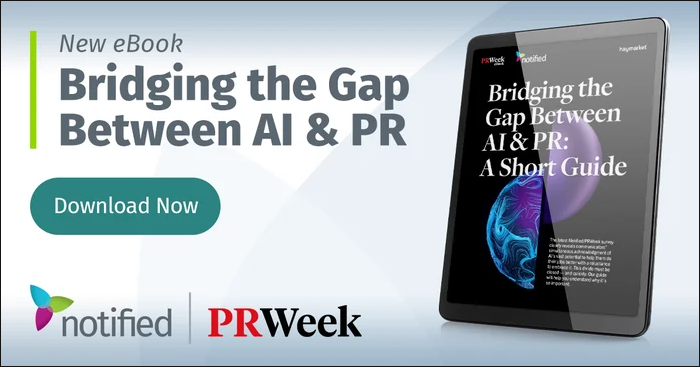Share this
Staying Ahead of the Game: Navigating the PR Landscape in 2024
by Michelle Garrett on Jan 24, 2024 3:47:48 PM
2024 is here – and in the public relations world, it looks like we’re in for quite a ride.
From artificial intelligence and macroeconomics to the more traditional challenges that come with working in PR, we have our plates full as we kick off the new year.
To stay ahead of the game and get a sense of what’s on the minds of public relations pros, I spoke with leaders from across the industry. Here are the trends they’ll be watching this year!

7 Public Relations Trends to Watch
1. It’s STILL the Economy
While many experts predict the economy will improve in 2024 (with interest rates expected to go down), some are still cautious based on the last couple of years of inflation and layoffs noted Jeff Stacey, Vice President of Product Management at Notified.
And brands will need to be cognizant of these conditions when it comes to their storytelling.
“Brands will need to be sensitive to the global cost of living crisis, world conflicts and the challenges of climate change,” said Sangeeta Waldron, author and founder of Serendipity PR & Media. “All of this will reinforce the importance of focusing on human stories and connections rather than just brand messaging.”
It’s also a presidential election year in the United States, meaning stories surrounding that will consume much of the news media’s time and attention, as well as that of consumers.
Both could make it a challenging time for those in PR.
2. The Impact of Artificial Intelligence on Public Relations
To say AI (i.e. generative AI tools) were a focus in 2023 would be an understatement. But what role will it play this year?
“While AI will play an important role, it’s not the ‘magic bullet’ brand leaders think it is for content marketing or cost-savings for public relations,” said Bill Byrne, Managing Director of Remedy Public Relations.
“I hope to see growth in supporting PR and communications leaders to provide strategic counsel on the reputational risks of AI to businesses and organizations,” said Stuart Bruce, co-founder of communications transformation consultancy Purposeful Relations and the founder of crisis and reputation management consultancy Stuart Bruce Associates.
“AI is rapidly replacing Google as the world’s largest reputation management engine,” continued Bruce. “Research by McKinsey shows that 29% of respondents are concerned about the impact of AI on organizational reputation but just 16% have done anything about it. Even if PR leaders aren’t implementing and using AI themselves, it’s essential they get expert advice on how to advise the C-suite on its reputational impact.”
3. Measurement Strides Within PR
PR measurement has always been a struggle. Will 2024 finally be the year we see some progress in this area?
“No one brags about their ad buy or paid influencer spend, so why do we judge the value of PR on advertising metrics?” said Byrne. “Most want to see metrics associated with a PR campaign, but very few want to allocate the effort or budget required to measure correctly.”
“In theory, AI can be a powerful aid to improving PR measurement, but the problem is that too many people don’t understand PR strategy, planning and measurement well enough to use AI effectively,” said Bruce. “We’re already seeing people trying to use AI to count and measure what they are doing, rather than asking themselves why they are doing it and what it is meant to achieve.”
4. Media Relations Remains Important – But It’s Still a Challenge
As one of the key elements in many a PR pro’s role, media relations continues to be challenging.
We’ve touched on some of the trends in our AI section, but developing relationships with journalists generally comes with its own set of trending issues. The downfall of Twitter (now X) over the past year or so has played into this trend.
“What’s going to happen to Twitter?” said Stacey.
Good question. While many former users have abandoned the platform entirely, journalists continue to embrace it. Perhaps this is because no attractive alternative has entered the scene.
Twitter (X) matters for PR pros who want to build relationships with journalists, but it also matters for journalists who turn to the social media outlet to get story ideas, as we see in poll after poll Stacey observed.
Another media relations trend is the rise of personalization when pitching. This involves being more strategic and focused when selecting who to pitch versus simply sending out pitches en masse.
Even before identifying the right journalist(s), ensure you know your audience – WHO are you trying to reach? Then, consider who will help you reach them.
“Journalists will ignore non-relevant (and relevant) email pitches more than ever,” said Paul Wilke, CEO at Upright Position Communications. “They’re so bombarded with pitches to the point that they’re going to ignore ALL pitches and just cover what they want to cover or what they discover from their own work.”
Storytelling is yet another trend that PR pros are focused on. While not new, its importance is increasing, especially due to the widespread use of generative AI tools to do more writing of pitches and press releases.
“Instead of bombarding audiences with generic brand messages, a human approach centered around sharing real stories emphasizing personal connections, along with the need for trust and transparency, and connecting beyond transactions will be vital,” said Waldron.
5. Technology and Public Relations Tools Help Get the Job Done
Press releases continue to play a critical role in public relations. Even in the age of AI, the use of PR tactics such as press releases isn’t going anywhere.
“Journalists still refer to press releases more than any other piece of content,” Stacey said. “When we look at surveys, journalists rank press releases at the top of the list of content they turn to when putting together stories. Multimedia content is increasingly vital as it boosts the pick-up rate of a release while helping reporters add visual elements to their stories.”
“As brands put together campaigns, press releases should be part of that. The content can be reused across multiple channels - such as on a company’s blog, social media and podcast,” said Stacey.
We could even argue that as the use of AI increases, audiences are becoming increasingly skeptical and may be thinking, “Was what I’m reading generated by AI?”
In an era where fake news is becoming easier to generate because of AI, press releases (and newswires such as GlobeNewswire) remain one of the most trustworthy vehicles for PR pros to share brand/client stories.
Trust matters more than ever with audiences, and companies will need to behave in a way that increases that bond with stakeholders.
6. Social Media Is Evolving
2023 was a year of upheaval for social media platforms. What might have worked last year may not work as well now.
“I believe that social media has evolved into a dynamic landscape, characterized by immersive experiences and community building functions and capabilities,” said Karen Freberg, Ph.D., Professor of Strategic Communication and Director of The Bird’s Nest student agency at the University of Louisville.
“We are seeing, of course, the rise of AI across the board – the good and the bad related to content creation to copyright infringement to deepfakes,” Freberg says. “We will continue to see platforms change and update their features, competing on what new tool or feature they can get users on board with. Pay-to-play will be the norm with algorithms changing even more frequently.”
“Video content will continue to dominate user engagement on platforms such as TikTok and Instagram Reels and YouTube and will become more evolved,” added Waldron.
“Social media will continue to be a strong hub for communication, dialogue and relationships – the platforms will change, but human beings will spend their time and attention to the platforms and places where they will get value, empathy, positivity and community,” said Freberg.
7. ESG On the Radar
If ESG communications (Environmental, Social and Corporate Governance) aren’t yet on a brand’s radar, it needs to be in 2024.
Why? ESG is now a top-three key purchasing criterion for more than half of consumers globally.
“Brands will need to be honest, particularly regarding their 'green communications,' especially if they want to avoid being called out for greenwashing,” said Waldron. “This is the year for all brands to seize the opportunity to be transparent and step up to do better for our planet.”
Enjoy this article? Subscribe to the Notified blog to stay up on the latest public relations trends! You’ll get a weekly roundup of new posts sent to your inbox each Friday.

Share this
- Public Relations (225)
- Press Releases (115)
- Press Release Distribution (94)
- GlobeNewswire (90)
- Investor Relations (88)
- PR Communications (75)
- Artificial Intelligence (72)
- Media Relations (50)
- IR Communications (41)
- Media Contacts Database (40)
- Global News Distribution (32)
- Webinar (32)
- IR Websites (30)
- Earnings Calls (22)
- Notified PR Platform (21)
- IR Webcasts (19)
- Experiences (17)
- Studio Webinar Platform (17)
- Virtual Events (17)
- Writing Tips (17)
- Case Study (16)
- PR Trends (16)
- Webcasts (16)
- PR Measurement (15)
- Generative AI (13)
- Media Monitoring (13)
- Event Technology (12)
- Investor Days (12)
- Webinar Strategy (12)
- ESG (10)
- Social Media (10)
- IR Event Platform (9)
- Newswire (9)
- United Kingdom (9)
- Virtual Event Platform (9)
- Accessibility (8)
- Earnings Day (8)
- Earnings Release (8)
- News Roundup (8)
- Regulatory Filing (8)
- Germany (6)
- Report (6)
- Social Listening (6)
- CLEAR Verified (5)
- IR Hub (5)
- Video (5)
- Webinar Engagement (5)
- Brand Storytelling (4)
- Misinformation (4)
- PR Agency (4)
- SEO (4)
- Trust (4)
- IR Trends (3)
- Journalism (3)
- AGM (2)
- Awards (2)
- Branding (2)
- CSR (2)
- Capital Narratives (2)
- DEI (2)
- Demand Generation (2)
- Insights & Analytics (2)
- ROI (2)
- Sentiment Analysis (2)
- Webhosting (2)
- Annual General Meeting (1)
- Canada (1)
- Emojis (1)
- Equiniti (1)
- Events (1)
- France (1)
- Halloween (1)
- Internal Communications (1)
- Internships (1)
- Life At Notified (1)
- Mark Cuban Foundation AI Bootcamp (1)
- Marketing (1)
- News Briefs (1)
- News Releases (1)
- PRSA ICON (1)
- Product Launch (1)
- Retail Investors (1)
- SXSW (1)
- Share of Voice (1)
- Sponsorships (1)
- Success Story (1)
- White Paper (1)
- eBook (1)
- September 2025 (4)
- August 2025 (6)
- July 2025 (9)
- June 2025 (12)
- May 2025 (9)
- April 2025 (11)
- March 2025 (11)
- February 2025 (6)
- January 2025 (12)
- December 2024 (12)
- November 2024 (12)
- October 2024 (14)
- September 2024 (15)
- August 2024 (14)
- July 2024 (14)
- June 2024 (14)
- May 2024 (12)
- April 2024 (13)
- March 2024 (13)
- February 2024 (15)
- January 2024 (11)
- December 2023 (7)
- November 2023 (13)
- October 2023 (14)
- September 2023 (7)
- August 2023 (8)
- July 2023 (7)
- June 2023 (8)
- May 2023 (8)
- April 2023 (5)
- March 2023 (5)
- February 2023 (8)
- January 2023 (9)



